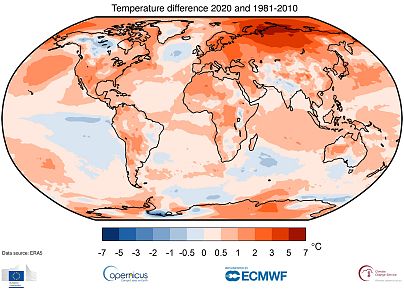While Europe was boiling, parts of the Southern Hemisphere saw below-average temperatures, most notably over the eastern equatorial Pacific, which was associated with La Niña conditions, a cooling event, that developed during the second half of the year.
Europe saw its warmest ever year in 2020, 0.4°C warmer than the previous record in 2019, according to the EU's climate monitoring service.
The latest data released from Copernicus also showed that, worldwide, 2020 was on par with the warmest year ever recorded - 2016 - marking the end of the warmest decade on record.
The agency also reported that CO2 concentrations in the atmosphere have continued to rise globally.
In Europe, seasonal data for winter 2019/20 and autumn 2020 showed they were also the warmest ever recorded.
Winter (December 2019 to February 2020) exceeded the previous warmest of 2016 by almost 1.4°C, while autumn (September to November 2020) passed the old record set in 2006 by 0.4°C.
Arctic sea ice hits record low
Parts of the Arctic and northern Siberia saw some of the largest divergences from the average annual temperature for these areas in 2020, with a large region seeing differences of 3°C and in some places even 6°C.
The wildfire season was unusually active in this region, with fires first detected in May and continuing throughout summer and well into autumn.
As a result, fires released a record 244 megatonnes of carbon dioxide in 2020, over a third more than the 2019 record.
During the second half of the year, Arctic sea ice was significantly lower than average for the time of the year with July and October seeing the lowest sea ice extent (the area of ocean where there is at least some sea ice) on record.
2020 still logs record temperatures despite cooling La Niña
In general, the Northern Hemisphere experienced above-average temperatures for the year, apart from a region over the central North Atlantic.
But parts of the Southern Hemisphere saw below-average temperatures, most notably over the eastern equatorial Pacific, which was associated with La Niña conditions, a cooling event, that developed during the second half of the year.
An unusually intense El Niño event, La Niña's warmer counterpart, occurred in 2016, and Copernicus says it is telling that 2020 matches the 2016 global temperature record despite this.












